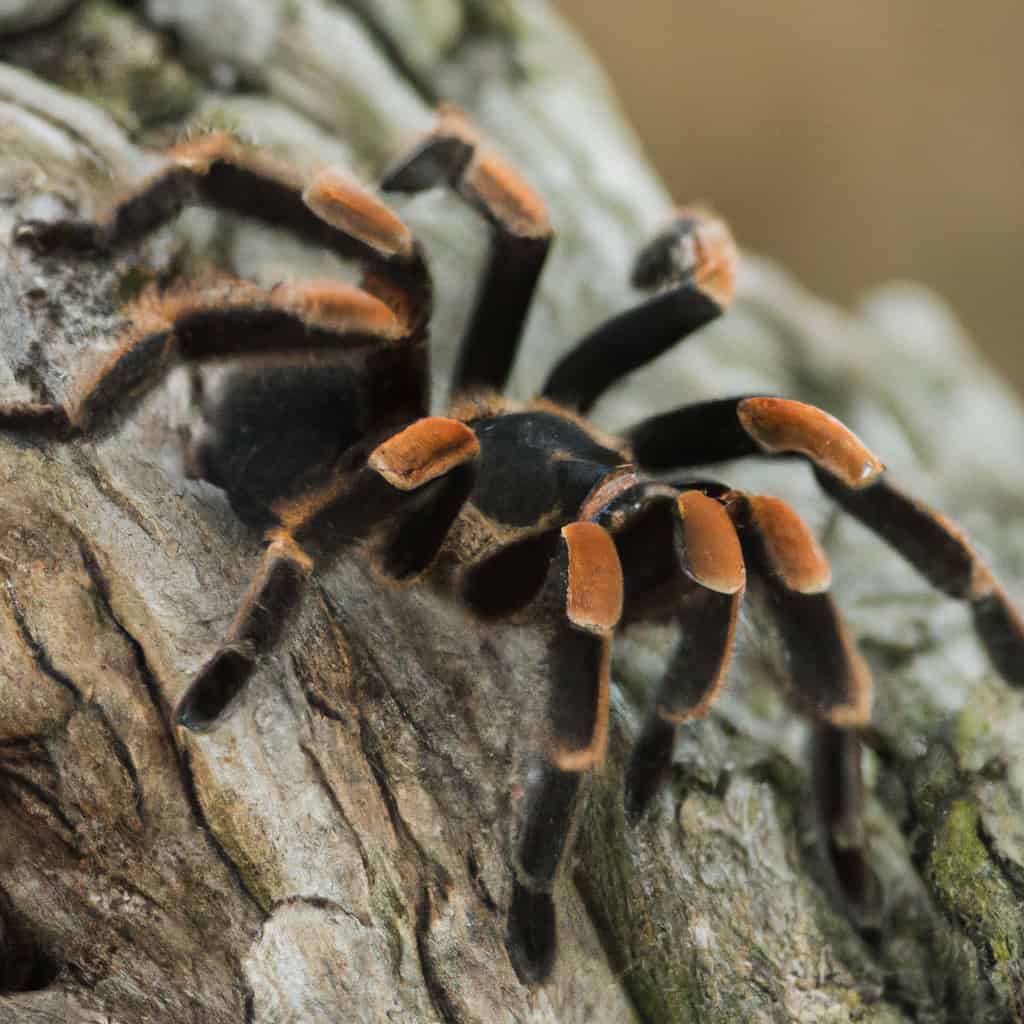How far can a tarantula jump? As someone who has owned tarantulas before, this is a question that has always piqued my curiosity. After doing some research, I found that the answer is not as straightforward as one might think. While all tarantulas are capable of explosive movements, not all of them can jump.
Understanding tarantulas is crucial in answering this question. Tarantulas are a type of spider that belong to the family Theraphosidae. They are known for their large size, hairy bodies, and venomous fangs. While some species are ground-dwelling, others are arboreal, meaning they live in trees. This distinction is important because arboreal tarantulas are the ones that are capable of jumping.
Key Takeaways
- Not all tarantulas can jump, only arboreal ones have the ability to do so.
- Some arboreal tarantulas can jump up to 2 feet high.
- Jumping is a defense mechanism for tarantulas when they feel threatened.

Understanding Tarantulas
As someone who has always been fascinated by the world of arachnids, I find tarantulas to be some of the most interesting creatures out there. These large, hairy spiders are found all over the world, with many different species and sub-species to explore.
One of the first things to understand about tarantulas is that they are part of the Araneae order, which means they are true spiders. They are also part of the Theraphosidae family, which includes many of the world’s largest spiders. Most tarantulas are terrestrial, meaning they live on the ground, but some are arboreal, which means they live in trees.
When it comes to tarantulas, there are two main groups: old world species and new world species. Old world species are found in Asia, Africa, and Europe, while new world species are found in the Americas. The tarantulas found in South America are some of the most well-known, including the pink toe tarantula (Avicularia avicularia) and the Brazilian black tarantula (Grammostola pulchra).
One thing that many people wonder about tarantulas is whether or not they can jump. The answer is yes, tarantulas can jump, but the distance and height of their jumps varies depending on the species. Some species can jump up to two feet high, while others can only jump a few inches.
Tarantula Anatomy
As a tarantula owner, I’ve learned a lot about the anatomy of these fascinating creatures. Tarantulas have a unique body structure that sets them apart from other spiders. Let’s take a closer look at some of the key features of tarantula anatomy.
Legs and Body Length
Tarantulas are known for their long, hairy legs. Most species have eight legs, but some have ten. The length of a tarantula’s body can vary greatly depending on the species. Some are only a few inches long, while others can be as large as a dinner plate.
Abdomen and Cephalothorax
Tarantulas have two main body parts: the abdomen and the cephalothorax. The abdomen is the larger part of the body and contains the tarantula’s vital organs. The cephalothorax is the smaller part of the body and contains the head and legs.
Pedipalps
Tarantulas also have two small, leg-like appendages called pedipalps. These are used for a variety of purposes, including sensing the environment, grabbing prey, and mating. Unlike the legs, the pedipalps only have one claw each.
Urticating Hairs
One unique feature of tarantulas is their ability to shoot urticating hairs from their abdomen. These hairs are barbed and can cause irritation or even injury to predators. Tarantulas will often kick these hairs when threatened as a defense mechanism.
Exoskeleton
Like all arachnids, tarantulas have an exoskeleton. This hard outer shell provides protection and support for the tarantula’s body. As the tarantula grows, it will shed its exoskeleton in a process called molting.
Jumping Mechanism
Have you ever wondered how far a tarantula can jump? Well, let’s dive into the jumping mechanism of these agile creatures.
Tarantulas have a unique hydraulic mechanism that allows them to perform explosive movements, including jumping. This mechanism is powered by the tarantula’s circulatory system, which uses hemolymph instead of blood. Hemolymph is a fluid that circulates throughout the tarantula’s body and is responsible for delivering nutrients and oxygen to its muscles.
When a tarantula jumps, its muscles contract, and the hemolymph is forced into the legs, causing them to extend rapidly. This rapid extension of the legs propels the tarantula forward, allowing it to jump.
The jumping ability of tarantulas varies depending on the species. Some tarantulas can jump up to two feet, while others can only jump a few inches. The jumping ability also depends on the tarantula’s size and weight. Smaller tarantulas are generally more agile and can jump farther than larger ones.
It’s important to note that not all tarantulas can jump. Arboreal tarantulas, such as the pink toe tarantula, are more likely to jump than terrestrial tarantulas. However, even terrestrial tarantulas are capable of performing explosive movements that can help them escape predators or catch prey.
Factors Influencing Jumping Ability
As I was researching about tarantulas, I found out that several factors can influence how far a tarantula can jump. Here are some of the factors that I discovered:
Size and Weight
Larger tarantulas may not be able to jump as high or as far as smaller tarantulas due to their size and weight. This is because larger tarantulas have more muscle mass and are able to generate more force when they jump, but at the same time, their weight can limit their jumping ability. So, if you’re looking for a tarantula that can jump far, you might want to consider getting a smaller one.
Age
Age is another factor that can affect a tarantula’s jumping ability. Older tarantulas may have reduced muscle mass and mobility, which can limit their jumping ability. So, if you want a tarantula that can jump far, you might want to consider getting a younger one.
Surface and Habitat
The type of surface and habitat can also affect a tarantula’s jumping ability. Tarantulas that live in trees or other elevated surfaces may have better jumping ability than those that live on the ground. This is because they need to be able to jump to catch their prey or avoid predators.
Food
The type and amount of food that a tarantula eats can also affect its jumping ability. A well-fed tarantula may have more energy to jump farther than a hungry one.
Molting
When a tarantula molts, it sheds its old exoskeleton and grows a new one. During this process, the tarantula is vulnerable and may not be able to jump as far as it normally would.
Energy
Like any other animal, a tarantula needs energy to jump. A tarantula that is low on energy may not be able to jump as far as one that is well-fed and rested.
Water
Finally, water can also affect a tarantula’s jumping ability. A tarantula that is dehydrated may not be able to jump as far as one that is well-hydrated.
Jumping as a Defense Mechanism
As a tarantula, I have a few defense mechanisms to protect myself from predators and threats. One of these mechanisms is jumping, which I can use to escape from danger quickly. While tarantulas are not known for their jumping abilities, we can still jump when we need to.
Jumping is particularly useful when we are being attacked by ambush predators, such as snakes or birds. These predators rely on surprise attacks to catch their prey, but if we can jump out of the way quickly, we have a better chance of surviving the attack.
However, jumping is not our primary defense mechanism. We have other ways of protecting ourselves, such as using our venom to subdue our prey or attackers. Some tarantulas have highly toxic venom that can cause serious harm to humans and other animals.
When it comes to jumping, some species are better at it than others. Arboreal tarantulas, such as the pink toe tarantula, are more likely to jump than ground-dwelling tarantulas. This is because they need to be able to move quickly and efficiently through the trees to catch their prey.
Tarantulas in Captivity
As a tarantula owner, I know firsthand how fascinating these creatures can be. Tarantulas are surprisingly docile in captivity, and they would rather avoid humans if at all possible. However, it is important to note that tarantulas are not pets for everyone. They require specific care and handling, and it is important to do your research before deciding to get one.
When it comes to handling tarantulas, it is important to be gentle and use caution. They are delicate creatures and can easily be injured if mishandled. It is recommended to use tweezers or a soft brush to handle them, as this will reduce the risk of injury to both you and your tarantula.
In terms of enclosure, tarantulas require a specific type of environment to thrive in captivity. It is important to provide a secure and spacious enclosure that mimics their natural habitat. This includes providing hiding spots, a water dish, and appropriate substrate.
One species of tarantula that is popular in captivity is the Avicularia avicularia, also known as the “pink toe” tarantula. This species is known for its ability to jump, and it is important to provide a secure enclosure to prevent any potential falls.
The Misconceptions About Tarantulas
As someone who has spent a lot of time studying tarantulas, I have noticed that there are many misconceptions about these fascinating creatures. Let’s take a look at some of the most common misconceptions and clear them up.
Tarantulas are Aggressive
One of the biggest misconceptions about tarantulas is that they are aggressive and will attack humans. In reality, tarantulas are quite docile and will only bite if they feel threatened. Most tarantula bites are no worse than a bee sting and are not dangerous to humans.
Tarantulas are Fragile
Another misconception about tarantulas is that they are fragile and can be easily injured or killed. While tarantulas are not invincible, they are actually quite hardy creatures. They can survive falls from several feet without being injured, and they are able to regenerate lost limbs.
Tarantulas Jump High
Many people believe that tarantulas are able to jump several feet in the air. While some species of tarantulas are able to jump, they are not capable of jumping very high. The average jump height for a tarantula is only a few inches, and only a few species are able to jump up to a foot or more.
Tarantulas are Scary
Finally, there is a common misconception that tarantulas are scary and should be feared. While tarantulas may look intimidating, they are actually quite fascinating creatures. They are important members of their ecosystems and play an important role in controlling insect populations.
Tarantulas in Popular Culture
I always find it fascinating how animals, even the creepy crawly ones, can make their way into popular culture. Tarantulas, with their large size and hairy appearance, have certainly made their mark in movies, TV shows, and even children’s books.
One of the most iconic tarantula scenes in movie history is from the 1955 film “Tarantula”. In the film, a scientist accidentally creates a giant tarantula that terrorizes a small town. The film’s special effects were impressive for the time and the tarantula looked quite realistic, even if it was a bit oversized.
Tarantulas have also made appearances in children’s books. One such book is “Diary of a Spider” by Doreen Cronin. The book is written from the perspective of a young spider and follows his adventures with his spider and insect friends. Tarantulas are featured in the book as one of the spider’s neighbors.
In terms of TV shows, tarantulas have made their way into a variety of nature documentaries. These documentaries often showcase the impressive jumping ability of some tarantula species, which can jump up to 2 feet high! It’s certainly a sight to see these large spiders leaping through the air.
Conclusion
So, can tarantulas jump? The answer is yes, they can. However, not all species of tarantulas are capable of jumping. Arboreal tarantulas, such as Avicularia avicularia, are more likely to jump than terrestrial tarantulas due to their lighter weight and more agile bodies.
Research has shown that some tarantulas can jump up to 2 feet high, which is quite impressive considering their size. However, it’s important to note that not all tarantulas can jump this high and some may not be able to jump at all.
Frequently Asked Questions
How fast can a tarantula run?
Tarantulas are not known for their speed. They are slow-moving creatures and can only crawl at a leisurely pace. They are not built for speed, but for stealth. They prefer to ambush their prey rather than chase it down.
Can tarantulas climb walls?
Yes, tarantulas are excellent climbers. They have specialized hairs on their legs that allow them to grip onto surfaces, including walls and ceilings. This adaptation helps them to move around their environment more easily and to avoid predators.
Do tarantulas jump at you?
Most tarantulas do not jump, and they are not aggressive towards humans. They would rather avoid confrontation and will only bite if they feel threatened. However, some species of tarantulas can jump up to several feet in the air, so it’s best to keep a safe distance from them.
How far can a Texas tarantula jump?
Texas tarantulas are not known for their jumping abilities. They are ground-dwelling spiders that prefer to crawl rather than jump. However, if they feel threatened, they may jump a short distance to escape danger.
Can tarantulas kill you?
Most tarantulas are not dangerous to humans. Their venom is not potent enough to cause serious harm, and they would rather avoid confrontation than attack. However, there are a few species of tarantulas that have venom that can cause severe pain, so it’s best to avoid handling them.
How likely is a tarantula to bite you?
Tarantulas are not aggressive towards humans, and they would rather avoid confrontation than bite. However, if they feel threatened, they may bite as a defense mechanism. The likelihood of getting bitten by a tarantula depends on the species and the situation. It’s best to avoid handling them and to give them their space.








